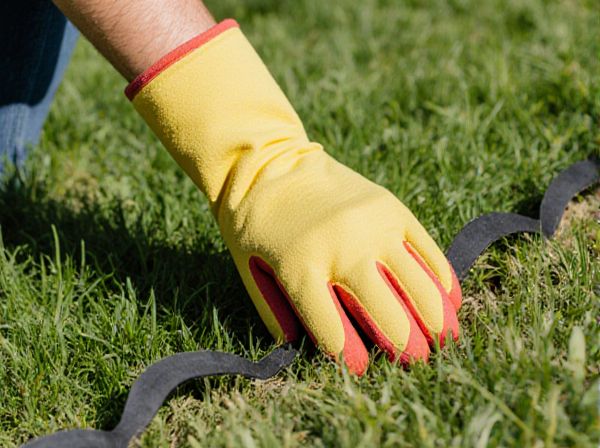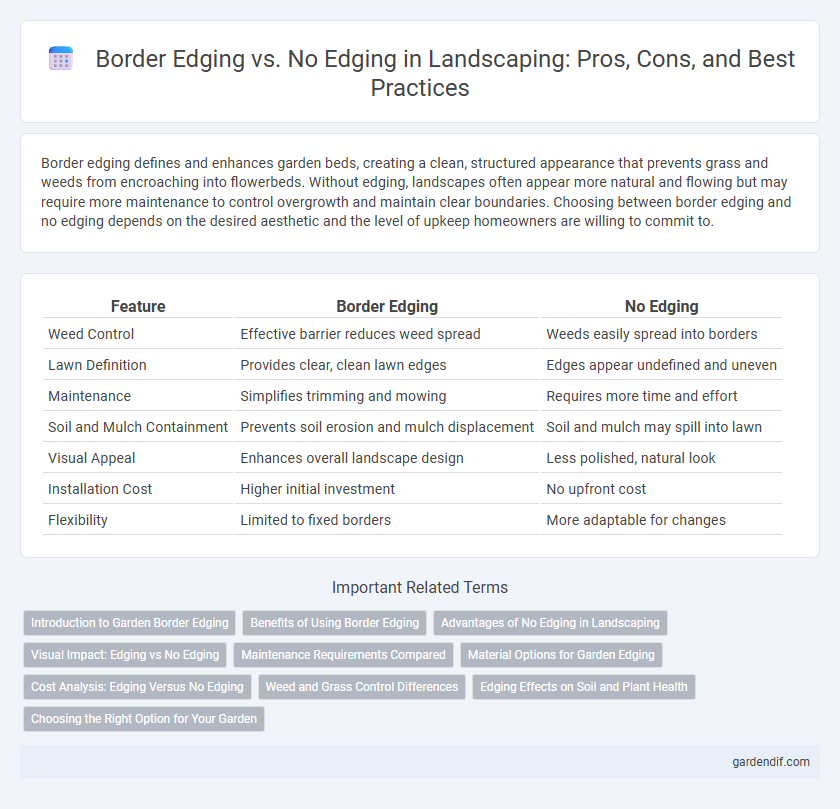
Border Edging vs No Edging Illustration
Border edging defines and enhances garden beds, creating a clean, structured appearance that prevents grass and weeds from encroaching into flowerbeds. Without edging, landscapes often appear more natural and flowing but may require more maintenance to control overgrowth and maintain clear boundaries. Choosing between border edging and no edging depends on the desired aesthetic and the level of upkeep homeowners are willing to commit to.
Table of Comparison
| Feature | Border Edging | No Edging |
|---|---|---|
| Weed Control | Effective barrier reduces weed spread | Weeds easily spread into borders |
| Lawn Definition | Provides clear, clean lawn edges | Edges appear undefined and uneven |
| Maintenance | Simplifies trimming and mowing | Requires more time and effort |
| Soil and Mulch Containment | Prevents soil erosion and mulch displacement | Soil and mulch may spill into lawn |
| Visual Appeal | Enhances overall landscape design | Less polished, natural look |
| Installation Cost | Higher initial investment | No upfront cost |
| Flexibility | Limited to fixed borders | More adaptable for changes |
Introduction to Garden Border Edging
Garden border edging defines the boundaries between lawn and planting areas, creating a clean, organized appearance that enhances overall landscape design. Edging materials such as stone, metal, plastic, or brick prevent grass and weeds from encroaching into flower beds while maintaining soil and mulch in place. Without edging, garden borders often appear unstructured, leading to increased maintenance and reduced visual appeal.
Benefits of Using Border Edging
Using border edging in landscaping creates a clean separation between lawn, flower beds, and pathways, preventing grass and weeds from encroaching into designated garden areas. It enhances curb appeal by defining garden shapes and providing a polished, professional appearance. Border edging also reduces maintenance efforts by containing mulch and soil, helping to preserve plant health and garden aesthetics over time.
Advantages of No Edging in Landscaping
No edging in landscaping promotes natural soil erosion control and supports beneficial microbial activity by allowing roots to spread freely, enhancing overall plant health and ecosystem balance. It reduces maintenance time and costs by eliminating the need for frequent repairs or replacement of borders, contributing to sustainable landscape management. The absence of physical barriers also encourages organic integration between lawn and garden beds, creating a more seamless and aesthetically pleasing natural look.
Visual Impact: Edging vs No Edging
Border edging in landscaping creates a clean, defined separation between different areas such as flower beds, lawns, and pathways, enhancing the overall visual appeal and structure of the garden. Without edging, the landscape can appear more natural and fluid but may lack clear boundaries, leading to a slightly chaotic or unkempt look over time. Edging materials like stone, metal, or plastic contribute to a polished, organized appearance, making the garden design feel intentional and well-maintained.
Maintenance Requirements Compared
Border edging significantly reduces maintenance requirements by preventing grass and weeds from encroaching into flower beds, minimizing the need for frequent trimming and weeding. Without edging, garden borders require more regular upkeep to control plant overgrowth and maintain clean lines. Edging materials like metal, stone, or plastic create clear, durable boundaries that simplify garden upkeep over time.
Material Options for Garden Edging
Garden edging materials range from natural stones, brick, and metal to plastic and rubber, each offering varied durability and aesthetic appeal. Stone and brick provide a classic, long-lasting border ideal for formal garden designs, while flexible plastic and rubber options are cost-effective and easy to install for informal or curved layouts. Metal edging, often made from steel or aluminum, delivers a sleek, modern look with excellent longevity and resistance to weathering.
Cost Analysis: Edging Versus No Edging
Installing border edging in landscaping generally increases upfront costs by 15-30% due to materials like stone, metal, or plastic and labor-intensive installation. Choosing no edging reduces initial expenses but may lead to higher maintenance costs over time, such as frequent trimming and weed control. Cost analysis reveals that while edging requires more investment initially, it can lower long-term maintenance efforts and expenses, balancing overall budget considerations.
Weed and Grass Control Differences
Border edging creates a physical barrier that effectively prevents grass and weeds from encroaching into flower beds and landscaped areas, significantly reducing maintenance. Without edging, roots and runners of grass and weeds spread freely, increasing the likelihood of invasive growth and higher weed control efforts. Properly installed edging materials like metal, plastic, or stone serve as a long-term solution for maintaining clean, defined garden boundaries and minimizing weed intrusion.
Edging Effects on Soil and Plant Health
Border edging helps prevent soil erosion by maintaining soil structure and reducing nutrient loss, promoting healthier plant roots. Without edging, soil can wash away during heavy rains, leading to exposed roots and increased weed invasion. Proper edging also creates a barrier that limits root competition between garden beds and surrounding turf, enhancing plant growth.
Choosing the Right Option for Your Garden
Choosing between border edging and no edging depends on your garden's design and maintenance preferences. Border edging provides a clean separation between lawn and planting beds, preventing grass encroachment and enhancing curb appeal. Without edging, gardens can have a more natural look, but may require more frequent trimming and risk plant overgrowth into lawn areas.
Border Edging vs No Edging Infographic

 gardendif.com
gardendif.com